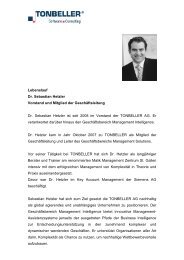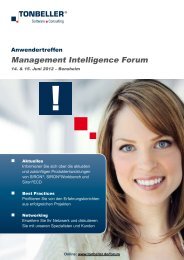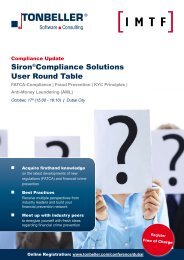Keep Money Laundering and Fraud out - TONBELLER® AG
Keep Money Laundering and Fraud out - TONBELLER® AG
Keep Money Laundering and Fraud out - TONBELLER® AG
You also want an ePaper? Increase the reach of your titles
YUMPU automatically turns print PDFs into web optimized ePapers that Google loves.
2.2.1 Customer Acceptance<br />
Whitepaper | <strong>Keep</strong> <strong>Money</strong> <strong>Laundering</strong> <strong>and</strong> <strong>Fraud</strong> <strong>out</strong> -<br />
Know your Customer (KYC)<br />
No account should be opened in the name of anonymous fictitious names. The challenges of KYC<br />
compliant client onboarding can now be consolidated <strong>and</strong> managed effectively in a single centralized,<br />
feature-rich solution. Siron ® KYC provides the capability required to enforce compliance policy while<br />
improving the efficiency of the customer acceptance process. With Siron ® KYC financial institutes are<br />
able to objectively identify those customers that carry higher than normal integrity risks for the bank.<br />
TONBELLER is supporting financial institutes to comply with “Know your Customer” regulations. By<br />
reading the following chapters you will get insights ab<strong>out</strong> the following tasks <strong>and</strong> KYC/customer<br />
acceptance requirements:<br />
� Banks shall classify customers into various risk categories (risk rating) during customer<br />
acceptance based on risk assessment (see 2.1.3 Assess Risks)<br />
� Each risk category has other acceptance criteria for each customer category (legal or natural<br />
person) (see 2.1.4 Assign Risk to Adequate Prevention Measures)<br />
� For the purpose of risk rating banks shall obtain the relevant information from customer at the<br />
time of customer acceptance (see 2.2.1.2 Dynamic Know your Customer Questionnaire)<br />
� Necessary checks shall be conducted before opening a new account to ensure that the<br />
identity of the customer does not match with any person with a known criminal background or<br />
with banned entities such as persons that are listed on an sanction-, watch-, black list (see<br />
2.2.1.3 PEP screening & watch list management)<br />
� Accept or reject customer after verifying the identity <strong>and</strong> after getting an underst<strong>and</strong>ing of the<br />
risks the potential customer poses to the bank<br />
2.2.1.1 Customer Identification Process (CIP)<br />
The customer identification process (CIP) is an integrated part of the “Know your Customer” process.<br />
As a financial institute’s CIP means that all customers (face-to-face & non-face-to-face) are properly<br />
identified through documented processes <strong>and</strong> that the identity of the potential client is verified during<br />
the customer acceptance by using reliable <strong>and</strong> independent source documents, data <strong>and</strong> information.<br />
The customer identification process provisions apply equally whether the client is a natural person or<br />
legal entity or company. However the identification requirements will vary between entity types:<br />
CIP – Natural Persons – What is needed?<br />
� Document proving the ID<br />
� Document proving address<br />
� Latest photograph<br />
� Document to verifying signature<br />
� …<br />
2-17
















